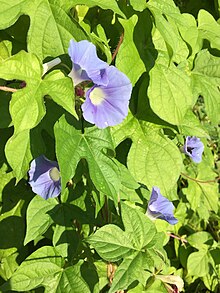Ipomoea hederacea
| Ivy-leaved morning glory | |
|---|---|

| |
| Scientific classification | |
| Kingdom: | Plantae |
| Clade: | Tracheophytes |
| Clade: | Angiosperms |
| Clade: | Eudicots |
| Clade: | Asterids |
| Order: | Solanales |
| Family: | Convolvulaceae |
| Genus: | Ipomoea |
| Species: | I. hederacea
|
| Binomial name | |
| Ipomoea hederacea Jacq.
| |
Ipomoea hederacea, the ivy-leaved morning glory or Kaladana,[2] is a flowering plant in the bindweed family. The species is native to tropical parts of the Americas, and has more recently been introduced to North America. It now occurs there from Arizona to Florida and north to Ontario and North Dakota. Like most members of the family, it is a climbing vine with alternate leaves on twining stems. The flowers are blue to rose-purple with a white inner throat and emerge in summer and continue until late fall. The leaves are typically three-lobed, but sometimes may be five-lobed or entire. Flowers occur in clusters of one to three and are 2.5–4.5 cm long and wide. The sepals taper to long, recurved tips and measure 12–24 mm long. The species shares some features with the close relative Ipomoea purpurea,[3] and is almost identical in appearance to wild forms of I. nil.
Ecology
The morning glories are little used by
Most of the pollinations of Ipomoea hederacea are achieved by self-pollination, with a selfing rate of 93% observed in one population.[4]
Ipomoea hederacea has been studied as a target of
Alkaloids
The seeds of the plant have been mentioned to contain up to 0.5% of lysergol, an ergoline alkaloid also found in other Ipomoea and fungi from the Claviceps genus.[6] Patents filed by the company Farmex describe the use of this plant for the production of such alakaloids,[7] even though the industrial relevancy of these processes is questionable when compared to other means of production.
References
- ^ NatureServe (2024). "Ipomoea hederacea". Arlington, Virginia. Retrieved 15 February 2024.
- ^ BSBI List 2007 (xls). Botanical Society of Britain and Ireland. Archived from the original (xls) on 2015-06-26. Retrieved 2014-10-17.
- ^ a b Miller, J.H., & Miller, K.V. (1999). Forest plants of the southeast and their wildlife uses. Champaign, IL: Kings Time Printing.
- .
- PMID 18171146.
- ISBN 9789057023750.
- ^ "Method for the extraction of lysergol and ergot alkaloids from plants of the ipomoea genus".
![]() Media related to Ipomoea hederacea at Wikimedia Commons
Media related to Ipomoea hederacea at Wikimedia Commons

